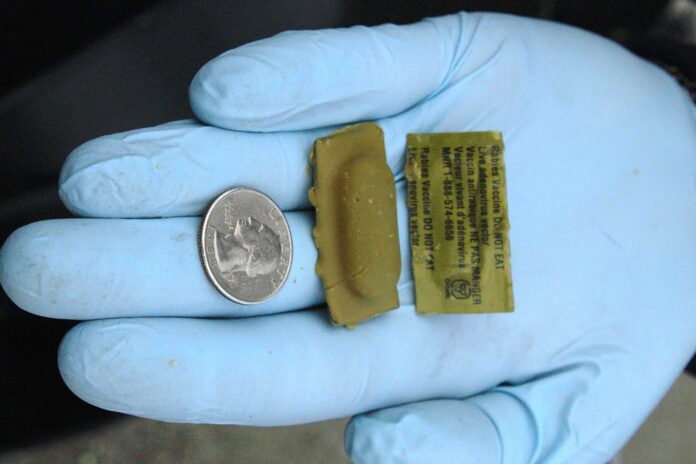
WASHINGTON — The U.S. Department of Agriculture’s Animal and Plant Health Inspection Service will continue field evaluation of the oral rabies vaccine bait ONRAB in eight states as part of its larger-scale rabies prevention effort. This year’s field evaluation will assess ONRAB’s distribution methods and effectiveness in raccoons, skunks and other wildlife.
APHIS’ Wildlife Services leads the cooperative National Rabies Management Program that works to prevent the spread of rabies in wildlife. Through this program, APHIS works with states and other partners across the country to manage and eliminate rabies in U.S. wildlife and protect public health and safety.
As human populations grow in suburban and rural areas, there is more interaction with wildlife. This increases the risk of rabies exposure for people and pets.
Serious concern
Rabies is a serious public health concern. While rabies is almost always fatal once symptoms appear, it also is 100% preventable. Human exposures can be successfully remedied if medical attention is sought immediately following exposure.
Costs associated with rabies detection, prevention and control may exceed $500 million annually in the United States. According to the CDC, about 90% of reported rabies cases in the U.S. are in wildlife. The program currently uses another rabies vaccine, RABORAL V-RG®, to control the disease in raccoons, coyotes and foxes. APHIS is now assessing whether the ONRAB vaccine can effectively manage rabies in raccoons and skunks.
Beginning in late July, APHIS and cooperators will distribute approximately 3.5 million ONRAB ORV baits in parts of Vermont, New Hampshire, Maine, New York, Ohio, Pennsylvania and West Virginia to test the immune effects in targeted wildlife.
Additionally, APHIS is conducting the final year of a small-scale project during October in Chattanooga, Tenn., to evaluate the effectiveness of ONRAB’s distribution methods. APHIS wildlife biologists will sample raccoons and skunks following bait distribution to determine vaccination rates.
Field evaluation of ONRAB during 2023 is a collaborative effort among APHIS, the U.S. Department of Health and Human Services’ Centers for Disease Control and Prevention, the vaccine manufacturer (Artemis Technologies Inc., an indirect, wholly owned subsidiary of Ceva Sante Animale S.A., Guelph, Ontario, Canada), and state departments of agriculture, health and natural resources.
Bait distribution
Throughout the month of August, distribution of this ORV bait will take place in the following counties in Ohio, Pennsylvania and West Virginia:
Ohio: Ashtabula, Belmont, Carroll, Columbiana, Geauga, Harrison, Jefferson, Lake, Mahoning, Monroe, Portage and Trumbull counties
Pennsylvania: Allegheny, Beaver, Crawford, Erie, Greene, Lawrence, Mercer, Washington and Westmoreland counties
West Virginia: Barbour, Brooke, Doddridge, Greenbrier, Fayette, Hancock, Harrison, Lewis, Marion, Marshall, McDowell, Mercer, Monongalia, Nicholas, Ohio, Pocahontas, Raleigh, Randolph, Summers, Taylor, Tyler, Upshur, Webster, Wetzel and Wyoming counties
The ONRAB bait is a blister pack filled with the vaccine and coated with a sweet attractant. When an animal bites into one of the baits, it will release the vaccine into their mouth and, with an adequate dose, develop immunity to rabies.
Humans and pets cannot get rabies from contact with the bait but are asked to leave the bait undisturbed if they encounter it.
If contact with bait occurs, the contact area should be immediately rinsed with warm water and soap. An intact bait is harmless, but it’s difficult to know if the bait was leaking vaccine while on the ground.
Each bait carries a toll-free number that people can call if they have additional questions concerning a bait contact.









